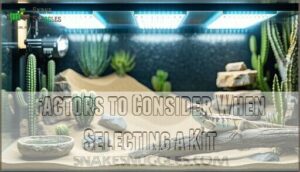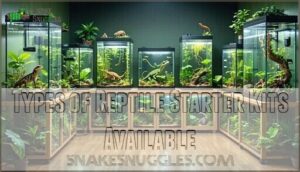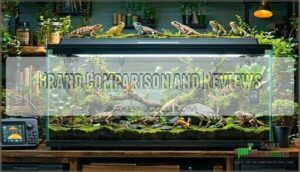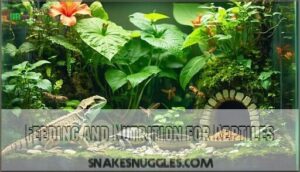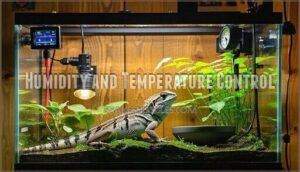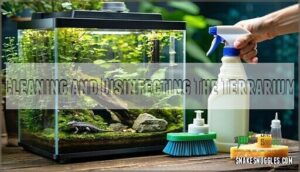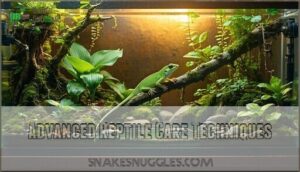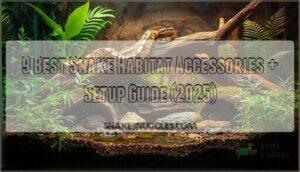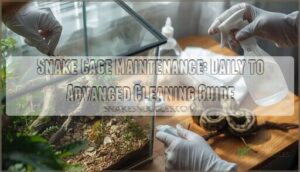This site is supported by our readers. We may earn a commission, at no cost to you, if you purchase through links.
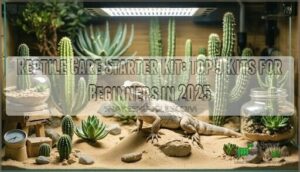
These extensive packages bundle essential components like heating elements, UV lighting, substrate, and humidity controls into one convenient purchase.
You’ll find species-specific options for bearded dragons, leopard geckos, and corn snakes, with environments ranging from desert to tropical setups.
Quality kits prevent the common mistakes that cause 70% of reptile health issues during the first month of ownership.
They’re designed for beginners who want to create a thriving habitat without needing a herpetology degree.
The right kit transforms overwhelming setup decisions into straightforward success—but choosing between desert, tropical, and specialized options requires knowing exactly what your scaly friend needs.
Table Of Contents
- Key Takeaways
- Reptile Care Basics
- Choosing Reptile Starter Kits
- Top 9 Reptile Care Starter Kits
- 1. Desert reptile starter habitat kit
- 2. Mini Reptile Terrarium Starter Kit
- 3. Reptile starter habitat kit desert
- 4. Tropical Reptile Vertical Habitat Kit
- 5. Jumping Spider Care Starter Kit
- 6. Portable Reptile Terrarium Kit System
- 7. Small reptile starter kit enclosure
- 8. Portable Reptile Travel Carrier Kits
- 9. Reptile Terrarium Starter Kit Tank
- Reptile Care and Maintenance
- Advanced Reptile Care Techniques
- Frequently Asked Questions (FAQs)
- Where can I buy a pet reptile starter kit?
- What is included in the tropical reptile starter kit?
- What items are eligible for a turtle starter kit?
- What comes in a turtle starter kit?
- What supplies should I buy for my pet turtle?
- What is the easiest reptile to care for?
- What’s the hardest reptile to take care of?
- Do reptiles like to be left alone?
- What warranty coverage comes with starter kits?
- How long do starter kit components typically last?
- Conclusion
Key Takeaways
- Match your kit to your reptile’s species – Desert reptiles, like bearded dragons, need different heating and humidity than tropical species, so you cannot use a one-size-fits-all approach
- Quality kits prevent 70% of first-month health issues – Proper starter kits include essential components, like UVB lighting, temperature gradients, and species-appropriate substrates, that prevent common beginner mistakes
- Plan for your reptile’s adult size – Do not choose a kit based on your pet’s current size, since most reptiles quickly outgrow smaller enclosures, requiring expensive upgrades
- Expect to upgrade certain components – Most starter kits include basic thermometers and bulbs that you will need to replace with higher-quality equipment for long-term success
Reptile Care Basics
You’ll need the right setup to keep your reptile healthy and thriving in captivity.
Starter kits provide the essential components like proper enclosures, heating systems, and species-specific accessories that prevent common health issues before they start, including proper enclosures and species-specific accessories.
Essential Components for Reptile Care
Setting up your reptile’s home correctly from day one prevents costly mistakes and health issues down the road. Every reptile species has non-negotiable requirements that you can’t skip or substitute.
Your reptile’s success depends on getting the basics right from day one – no shortcuts, no substitutions.
- Terrarium Lighting: UVB bulbs are essential for calcium absorption and preventing metabolic bone disease
- Reptile Substrate: Choose species-appropriate bedding to prevent impaction and maintain proper humidity levels
- Water Quality: Dechlorinated water and proper filtration systems keep your reptile healthy and hydrated
Your reptile starter kit should include these reptile care essentials as the foundation. Temperature gradients, hiding spots, and proper ventilation complete the reptile habitat setup. Think of it as building a miniature ecosystem – each component works together to create a thriving environment.
Species Research before purchasing guarantees you’re prepared for your reptile’s specific needs. Reptile Hygiene maintenance becomes routine when you start with quality equipment. A solid reptile enclosure setup following your reptile care guide makes the difference between a surviving pet and a thriving one.
Species-Specific Reptile Care
Different reptile species require customized care approaches for ideal health outcomes.
You can’t apply a one-size-fits-all method when selecting your reptile care starter kit.
Species Research determines your gecko starter kit needs versus bearded dragon requirements.
Proper Care Planning involves understanding specific Animal Behavior patterns and Habitat Design requirements for successful species-specific kits implementation.
| Species Category | Primary Care Requirements | Starter Kit Considerations |
|---|---|---|
| Desert Reptiles | High heat, UVB exposure, low humidity | Ceramic heaters, UVB bulbs, sand substrate |
| Tropical Species | Moderate heat, high humidity, UVA/UVB | Misting systems, live plants, cypress mulch |
| Nocturnal Geckos | Lower temperatures, hiding spots | Under-tank heaters, cave decorations |
| Arboreal Lizards | Vertical space, climbing branches | Tall enclosures, wooden perches |
| Aquatic Turtles | Water filtration, basking areas | Filter systems, turtle docks |
Reptile care for beginners becomes manageable when you match your leopard gecko starter kit to species-specific needs.
Reptile Nutrition varies considerably between insectivores, herbivores, and omnivores, making species identification your first priority before purchasing any reptile care starter kit.
Importance of Ventilation and Humidity Control
Proper air flow prevents respiratory infections and bacterial growth in your reptile habitat.
Most reptile care starter kits include ventilation systems with screen tops that maintain ideal humidity levels while ensuring fresh air circulation.
You’ll need to monitor moisture management closely – desert species require 30-40% humidity, while tropical reptiles need 60-80%.
Temperature control works hand-in-hand with ventilation for successful terrarium setup.
Maintaining the right humidity control levels is essential for preventing health issues in reptiles, and it requires careful consideration of humidity levels and ventilation systems to create a suitable environment.
Choosing Reptile Starter Kits
Selecting the right reptile starter kit depends on your specific species’ needs, enclosure size requirements, and your experience level.
Consider factors like heating methods, UVB lighting compatibility, and whether you want a basic setup or deluxe package with premium components, including the consideration of complete concepts.
Factors to Consider When Selecting a Kit
When you’re shopping for a reptile care starter kit, you’ll want to nail down these key factors before making your purchase:
- Kit Size – Match the enclosure dimensions to your reptile’s adult size, not just current measurements
- Species Needs – Desert reptiles require different heating and UVB setups than tropical species
- Ventilation and Humidity Control – Look for adjustable vents and proper airflow management systems
- Budget Constraints – Balance essential reptile care essentials for beginners with long-term upgrade potential
The right reptile starter kit components will grow with your pet’s needs.
Consider the importance of reptile habitat when selecting a kit.
Types of Reptile Starter Kits Available
When evaluating reptile starter kits, you’ll encounter several distinct categories designed for specific species and habitat requirements.
Each kit type serves different reptile needs and environmental preferences.
| Kit Type | Best For |
|---|---|
| Desert Habitat Kits | Bearded dragons, leopard geckos, desert tortoises |
| Tropical Sets | Chameleons, tree frogs, tropical geckos |
| Aquatic Kits | Turtles, semi-aquatic species |
| Arboreal Kits | Tree-dwelling species, climbing reptiles |
| Terrestrial Kits | Ground-dwelling snakes, lizards |
Desert habitat kits include heating elements and low-humidity substrates.
Tropical sets feature misting systems and moisture-retaining materials.
Aquatic starter enclosures combine land and water areas with filtration systems.
Each kit contains species-appropriate pet accessories and reptile starter kit components.
Reptile owners should research complete reptile starter kits to guarantee they provide the best environment for their pets.
Brand Comparison and Reviews
Zoo Med and Thrive dominate mainstream retailers, while The Bio Dude excels in bioactive systems.
ReptiBreeze and ReptiHabitat offer solid mid-range options with decent customer support.
Kit ratings reveal mixed results – budget kits often lack thermostats and proper UVB.
Price comparison shows starter costs range from $60-$300.
Brand reliability varies substantially, with specialized companies typically outperforming big-box alternatives in product quality and reptile care starter kit completeness.
When selecting a kit, consider the importance of reptile care to guarantee the best possible outcome for your pet.
Top 9 Reptile Care Starter Kits
You’ll find nine carefully selected reptile care starter kits that provide everything needed for successful reptile ownership.
Each kit includes essential components like proper heating, lighting, substrate, and housing to create ideal environments for different species, including proper heating and ideal environments.
1. Desert reptile starter habitat kit
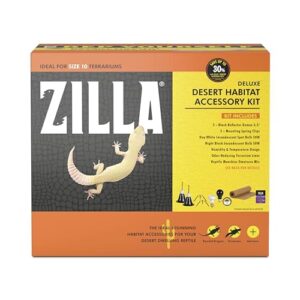
Desert reptile starter kits deliver everything you need for species like bearded dragons and leopard geckos.
These thorough packages include a glass terrarium (typically 10-20 gallons), dual dome fixtures with day and night bulbs, temperature gauges, and desert-appropriate substrate.
Most kits provide essential heating elements and ventilation systems.
However, you’ll likely need to upgrade the included thermometer and add UVB lighting for ideal health.
While bulbs may fail quickly, the core components offer solid value for beginners starting their reptile journey.
Best For: New reptile keepers seeking a convenient all-in-one kit for desert species like bearded dragons and leopard geckos.
- Includes heating, lighting, and substrate tailored for desert reptiles.
- Comes with easy-to-follow setup instructions and essential monitoring tools.
- Offers a more economical option compared to buying all components separately.
- Included light bulbs and thermometer often need upgrades or quick replacement.
- No UVB bulb provided, which is crucial for many desert reptiles.
- Some components, like carpet and decor, may not be ideal for long-term use.
2. Mini Reptile Terrarium Starter Kit
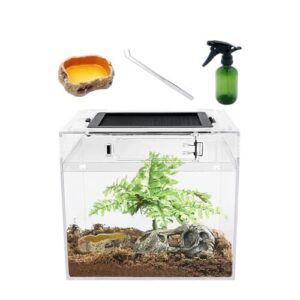
Many beginners choose mini reptile terrarium starter kits because they’re affordable and compact.
These kits typically include a 12" x 12" x 18" glass enclosure, substrate, lighting fixture, and thermometer.
The stainless steel screen top provides ventilation while the mini dome lamp delivers heat and UVB.
Most kits feature naturalistic décor like plastic plants and moss to replicate natural habitats.
While perfect for small species like juvenile geckos and tree frogs, you’ll need upgrades as your pet grows.
Best For: Beginners or casual hobbyists looking for a simple, all-in-one setup for small reptiles, amphibians, or tarantulas.
- Compact size fits easily in small spaces and is lightweight for transport.
- Includes essential accessories and setup guides for immediate use.
- Good ventilation and lighting options to support reptile health.
- Too small for larger reptiles or long-term housing as pets grow.
- Some kits lack critical items like UVB lights or proper hides.
- May require upgrades or extra purchases as the animal’s needs change.
3. Reptile starter habitat kit desert
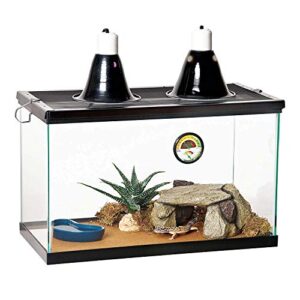
Building on arid-zone expertise, the Zilla Desert Reptile Terrarium Starter Kit delivers essential components for small desert species like leopard geckos and juvenile bearded dragons.
This 10-gallon glass enclosure includes dual reflective domes, night and day bulbs, screen cover, and humidity/temperature gauge. The brown terrarium liner fights odors and prevents impaction.
However, you’ll need additional UVB lighting for ideal reptile health. Users report reliable performance over three years, though replacement bulbs may be necessary.
Best For: Small desert reptiles such as leopard geckos, baby bearded dragons, or other juvenile desert species needing a starter habitat.
- Complete starter kit with essential heating, lighting, and environmental monitoring equipment included
- Easy-to-clean, non-abrasive terrarium liner designed to minimize odor and prevent digestive issues
- Setup guide and maintenance support make initial assembly straightforward, even for beginners
- Excludes UVB lighting, requiring additional purchases for certain reptile species
- Light bulbs and humidity/temperature gauges may malfunction or be less reliable, leading to extra expenses
- Tank size only suitable for juvenile or small species, not appropriate for adult reptiles or long-term housing
4. Tropical Reptile Vertical Habitat Kit
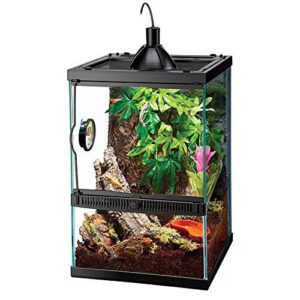
Between tropical humidity and vertical climbing space, this kit creates an ideal environment for arboreal species.
The 12" x 12" x 18" glass terrarium features a front-opening door and hinged screen top for easy access.
You’ll get coconut husk bedding, a mini halogen dome, and humidity gauges included.
The 5-inch deep base supports water features for semi-aquatic setups, making it perfect for crested geckos, tree frogs, and small chameleons requiring vertical territory.
Best For: Small arboreal reptiles and amphibians like crested geckos and tree frogs who need vertical climbing space and high humidity.
- Easy front and top access makes cleaning and feeding simple.
- Includes humidity/temperature gauges, bedding, and halogen lighting for quick setup.
- Deep water-tight bottom allows for semi-aquatic or paludarium features.
- Not suitable for larger reptiles such as iguanas or monitors.
- UVB lighting is not included and must be purchased separately for some species.
- Some customers report issues with shipping damage or base stability.
5. Jumping Spider Care Starter Kit
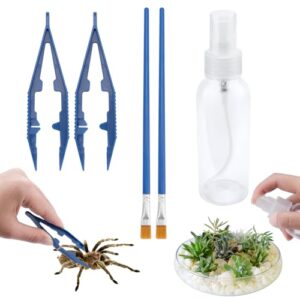
Professional arachnid-care kits provide essential tools for maintaining healthy jumping spider habitats.
These extensive starter packages include acrylic enclosures measuring 4"x4"x8", silk retreat pods, feeding cups, and fine mist sprayers.
You’ll receive hygrometers for monitoring 75% humidity levels and thermometers ensuring proper 68-77°F temperatures.
Each kit contains feeding starter packs with 25 mini mealworms and specialized tweezers for precise prey delivery.
The magnetic ventilation systems prevent escapes while maintaining airflow.
These all-in-one solutions eliminate guesswork for beginners managing these fascinating predators by including everything needed to create a suitable environment, making them a great choice for those who want a complete concept of arachnid care.
Best For: New or casual pet owners seeking an all-in-one solution for caring for jumping spiders, small reptiles, or terrarium setups.
- Complete kit includes all necessary tools for daily pet and terrarium care.
- Durable, scratch-free plastic tools designed for safe use with delicate pets.
- Suitable for a wide range of species and plant terrariums, offering flexibility.
- Does not include live feeder insects or actual habitat enclosures.
- Lacks advanced monitoring devices (like digital hygrometers or thermostats).
- Compact size may be limiting for larger setups or more experienced hobbyists.
6. Portable Reptile Terrarium Kit System
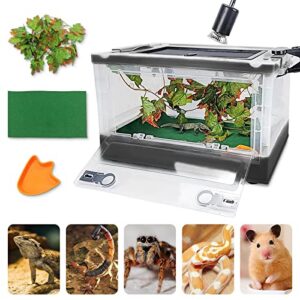
Portable systems revolutionize reptile care by offering lightweight, collapsible enclosures that weigh just 17 pounds for 24-gallon capacity.
You’ll appreciate the aluminum and polypropylene construction that assembles in minutes with included wheels for easy relocation.
These kits feature dual lamp fixtures with independent switches supporting both heat and UVB requirements, though bulbs are sold separately.
Deep bottom trays accommodate various substrates while built-in air vents provide necessary ventilation for a perfect environment, making them ideal for temporary housing, travel, or quarantine situations.
Best For: Frequent movers, reptile owners needing temporary housing, and anyone transporting small to medium reptiles for travel or emergencies.
- Not suitable as a permanent or long-term home for large or specialized reptiles.
- Bulbs for heating and UVB are sold separately, requiring extra purchases.
- Limited compatibility with under-tank heating and less effective ventilation compared to mesh enclosures.
- Lightweight and collapsible design makes setup, storage, and transport simple.
- Dual lamp fixtures and deep trays enable flexible heating, lighting, and substrate options.
- Integrated wheels and sturdy frame provide easy mobility and durability.
7. Small reptile starter kit enclosure
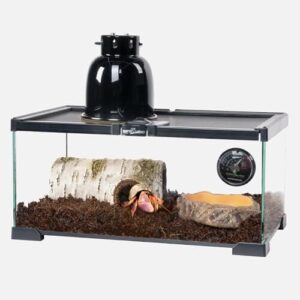
Compact enclosures measuring 12" x 8" x 6" offer perfect starter environments for baby reptiles and small species.
These glass tanks provide excellent visibility while maintaining proper humidity through mesh lids. You’ll find essential components like heat lamps, thermometers, and hiding spots included.
However, remember that growing reptiles quickly outgrow these spaces. Consider your pet’s adult size before committing to smaller setups that may become cramped, as this can affect the overall well-being of your pet in these smaller environments.
Best For: Beginners and hobbyists looking for a simple, all-in-one starter kit to house baby reptiles or small critters.
- Too small for most reptiles once they grow past the juvenile stage.
- Lacks the minimum recommended space for long-term reptile health and activity.
- Glass tanks can lose humidity and heat faster than insulated enclosures.
- Complete kit includes heat lamp, thermometer, feeding bowl, and hide cave for quick setup.
- High-quality glass tank offers good visibility and easy cleaning.
- Compact design is affordable and ideal for small pets or temporary housing.
8. Portable Reptile Travel Carrier Kits
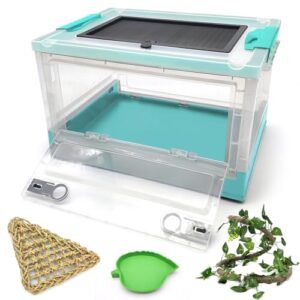
When you’re on the move with your scaly companion, travel carriers provide essential protection and comfort.
These lightweight carriers feature mesh ventilation panels and secure closures to prevent escapes during transport.
Most models weigh under two pounds and fold for easy storage. Look for carriers with washable bedding, food dishes, and temperature stability features.
Soft-sided options with shoulder straps work well for vet visits and short trips.
Best For: Reptile owners needing a portable, temporary housing solution for juvenile reptiles, geckos, or small pets during travel, vet visits, or isolation.
- Lightweight, foldable design for easy storage and transport
- Secure closures and mesh ventilation panels for safety and airflow
- Includes accessories like hammock, food tray, and removable bedding
- Not suitable for large reptiles or long-term habitation
- Ventilation holes and gaps may allow small pets or insects to escape
- Reports of warped panels and quality control issues
9. Reptile Terrarium Starter Kit Tank
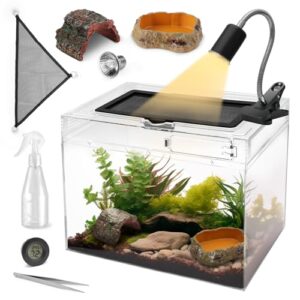
Standard reptile terrarium starter kits provide thorough housing solutions for beginners entering reptile care.
These kits typically include 10-40 gallon glass tanks with secure screen tops, essential heating equipment, and basic accessories.
You’ll find most kits feature thermometers, water dishes, and substrate materials.
Glass construction offers easy cleaning and excellent visibility for monitoring your pet’s behavior.
However, these tanks require careful temperature gradient management and may need equipment upgrades for long-term use.
Choose kits matching your reptile’s adult size requirements for ideal results to ensure a suitable environment for your pet, considering the need for secure screen tops.
Best For: Those needing a lightweight, portable, and fully-assembled enclosure for the short-term housing or transport of small reptiles, amphibians, or insects.
- Not recommended for permanent housing due to size and acrylic material limitations.
- Potential issues with heat lamp fit, lid alignment, and cleaning maintenance.
- Accessories and build may require upgrades for long-term reliability.
- 360-degree clear view with escape-proof locks and lots of accessories included.
- Ready to use out of the box—no assembly required and easy to carry for travel or vet visits.
- Suitable for a variety of small species including young reptiles or as a feeding/insect storage box.
Reptile Care and Maintenance
Once you’ve set up your reptile’s habitat, proper care becomes your daily routine to keep your pet healthy and thriving.
Understanding feeding schedules, temperature regulation, and cleaning protocols guarantees your reptile lives a long, comfortable life in their new home, which is crucial for a healthy life.
Feeding and Nutrition for Reptiles
Proper reptile diets form the foundation of successful reptile care for beginners.
Most reptiles consume 1-4% of their body weight daily, with juveniles requiring more frequent feeding schedules.
Reptile food should include appropriate food variety – herbivorous species need pellets comprising 25-50% of their diet, while omnivores require mixed greens, vegetables, and insects.
Nutrient supplements, particularly calcium and vitamin requirements, prevent metabolic bone disease.
Essential reptile care accessories include gut-loaded insects and proper feeding dishes for ideal reptile feeding success.
Heating and Lighting Requirements
Your reptile’s health depends on getting both reptile heating and reptile lighting right.
Most species need UVB lighting for calcium absorption and bone health. Heat mats provide gentle warmth, while halogen lamps create thermal gradients with hot and cool zones.
Your UVB lamp should run 10-12 hour lighting cycles to mimic natural daylight. Temperature control systems help maintain consistent heat source output for ideal reptile wellbeing.
Proper snake care involves understanding temperature gradients to create a healthy environment.
Humidity and Temperature Control
Maintaining ideal reptile humidity and temperature requires consistent monitoring and adjustment.
Install analog thermometers and hygrometers at both basking and cool zones to track temperature gradients. Most reptiles need 30-50% humidity levels, achieved through proper ventilation systems and controlled heat sources.
Regular thermometer calibration helps guarantee accurate readings for effective thermoregulation and temperature control. Accurate temperature readings also depend on using a reliable reptile thermometer to monitor the environment.
Effective temperature control is crucial for the health of reptiles, and it involves careful monitoring and adjustment of their surroundings.
Cleaning and Disinfecting The Terrarium
Keeping your reptile terrarium clean prevents disease and maintains a healthy environment.
Daily spot cleaning removes waste, while deep cleaning every 1-3 months tackles buildup.
Use hot water and mild dish soap for routine sanitizing tools and surfaces, and consider using reptile-safe cleaners for disinfecting.
Disinfecting methods include 10% bleach solution or reptile terrarium cleaners, and always remember to remove your pet first, rinse thoroughly, and guarantee complete drying before reassembly.
Regular terrarium cleaning requires proper maintenance to prevent the spread of disease.
Advanced Reptile Care Techniques
Once you’ve mastered the basics of reptile care, you’ll want to explore advanced techniques that enhance your pet’s quality of life and help you become a more skilled keeper.
These methods include creating naturalistic environments, proper handling techniques, health monitoring, and understanding breeding behaviors that can transform your reptile keeping from basic maintenance to expert-level husbandry.
They are essential for taking your reptile care to the next level, focusing on advanced techniques that make a significant difference in the life of your pet.
Creating a Naturalistic Environment
A well-designed naturalistic environment transforms your reptile terrarium into a thriving ecosystem.
Focus on Terrarium Design that mimics your pet’s native habitat using appropriate substrate, plants, and hiding spots.
Environmental Enrichment through varied textures, climbing structures, and Natural Lighting creates Ecosystem Balance.
Your vivarium should include terrarium accessories like branches, rocks, and caves that encourage natural behaviors and reduce stress.
Handling and Taming Reptiles
Building trust through proper reptile handling requires patience and understanding animal behavior. Start slowly with brief, gentle interactions to avoid stress responses that can damage your relationship permanently.
Trust builds through patience—respect your reptile’s natural instincts and move at their pace, not yours.
Essential Taming Techniques:
- Daily Observation Period – Watch your reptile’s body language for 15-20 minutes before attempting contact. Look for relaxed postures and normal breathing patterns.
- Progressive Touch Training – Begin with light finger contact on less sensitive areas like the back or sides, gradually increasing duration as tolerance builds.
- Consistent Handling Schedule – Maintain regular interaction times, preferably when your reptile is most active, to establish predictable routines that reduce anxiety.
Different species require specific approaches. Snake wrangling demands confident, steady movements, while lizard training benefits from slower, more deliberate actions. Gecko socialization often involves patience as these smaller reptiles need time to recognize human scent and voice patterns.
Recognizing and Treating Common Health Issues
Health monitoring starts with understanding warning signs.
You’ll spot Respiratory Issues through wheezing and open-mouth breathing.
Metabolic Bone Disease shows as lethargy and deformed limbs.
Skin Infections appear as reddened scales or blisters.
Parasite Control requires regular fecal exams.
Vitamin Deficiencies cause eye swelling and neurological symptoms.
| Health Issue | Key Symptoms | Immediate Action |
|---|---|---|
| Respiratory Issues | Wheezing, nasal discharge | Increase heat, see vet |
| Metabolic Bone Disease | Soft jaw, tremors | Add calcium, UVB light |
| Skin Infections | Red scales, blisters | Clean habitat, antibiotics |
Breeding and Propagating Reptiles in Captivity
Successful reptile breeding requires ideal environmental conditions and genetic management.
You’ll need proper temperature gradients, humidity control, and species-specific nesting areas for egg incubation success.
Essential breeding requirements include:
- Temperature Control – Maintain 26-33°C ranges for ideal reproduction
- Genetic Planning – Avoid inbreeding to prevent reduced hatchling survival
- Incubation Setup – Create controlled environments for egg development
- Hatchling Care – Provide specialized nutrition and habitat conditions
Most captive breeding programs achieve 90%+ hatching success with proper management.
Understanding breeding snakes techniques is vital for a successful reptile breeding program.
Frequently Asked Questions (FAQs)
Where can I buy a pet reptile starter kit?
Thirty-five percent of reptile owners use incomplete starter kits initially.
You’ll find complete reptile starter kits at PetSmart, Petco, Pet Supermarket, and specialty retailers like Swell Reptiles.
eBay offers budget-friendly options for cost-conscious beginners.
What is included in the tropical reptile starter kit?
The Naturalistic Terrarium Tropical Kit includes a 12"x12"x18" enclosure with built-in screen top.
The kit also comes with a Mini Deep Dome Lamp Fixture with 60W Daylight Blue Lamp, and Eco substrate for proper tropical environment setup.
What items are eligible for a turtle starter kit?
You’ll need a 20-gallon long aquarium (30"x12"x12"), screen top, Mini Combo Deep Dome Hood, 50W Repti Tuff Halogen Lamp.
Turtle dock, aquatic food, treats, and care guide are also necessary for proper setup.
You should have all the necessary equipment for the aquarium.
What comes in a turtle starter kit?
Twenty-gallon aquariums house 95% of aquatic turtle species successfully.
You’ll receive a 30"x12"x12" tank with screen top, heating dome, 50W halogen lamp, turtle dock, specialized food, treats, and care guide for complete setup.
What supplies should I buy for my pet turtle?
You’ll need a proper aquarium with filtration, basking area, UVB lighting, water heater, quality turtle food, and regular water testing supplies for peak health.
What is the easiest reptile to care for?
Looking at reptile care like choosing your first trusty steed, you’ll want a leopard gecko.
They’re hardy, docile, and require minimal husbandry compared to other species.
Their simple heating, feeding, and housing needs make them perfect beginner reptiles.
What’s the hardest reptile to take care of?
Chameleons top the difficulty list because they’re stress-prone creatures requiring precise humidity levels, specialized UVB lighting, and complex temperature gradients.
You’ll battle respiratory infections, parasites, and their notorious reluctance to eat when stressed.
Do reptiles like to be left alone?
Most reptiles prefer minimal handling and thrive when left undisturbed.
They’re naturally solitary creatures who don’t seek companionship like mammals do.
You’ll provide better care by observing them quietly rather than frequent interaction, which allows them to maintain their naturally solitary lifestyle and thrive when undisturbed.
What warranty coverage comes with starter kits?
Warranty terms vary by manufacturer and retailer.
Most companies offer limited warranties covering manufacturing defects for 30-90 days.
You’ll typically need receipts, and damage from misuse isn’t covered.
Always check specific warranty policies before purchasing kits, as understanding these terms is crucial for making informed decisions about warranty coverage.
How long do starter kit components typically last?
Most starter kit components last 1-3 years with proper care. Heat bulbs need replacing every 6-12 months, while UVB bulbs require replacement every 12 months for maximum effectiveness.
Conclusion
Success depends on your species selection and commitment to proper setup protocols.
The reptile care starter kit you choose determines your pet’s long-term health outcomes and your experience as a keeper.
Desert species require different parameters than tropical ones, making kit selection critical.
These nine options provide evidence-based solutions for beginners entering reptile husbandry.
Your scaly companion’s survival depends on choosing the right foundation from day one.
- https://talis-us.com/blogs/news/beginners-guide-reptile-starter-kits
- https://www.petsmart.com/reptile/starter-kits
- https://reptilesupershow.com/essential-reptile-habitat-setup-guide-tips/
- https://www.zenhabitats.com/blogs/reptile-care-sheets-resources/how-to-set-up-a-naturalistic-reptile-enclosure
- https://flukerfarms.com/blog/understanding-the-basics-of-reptile-lighting/

